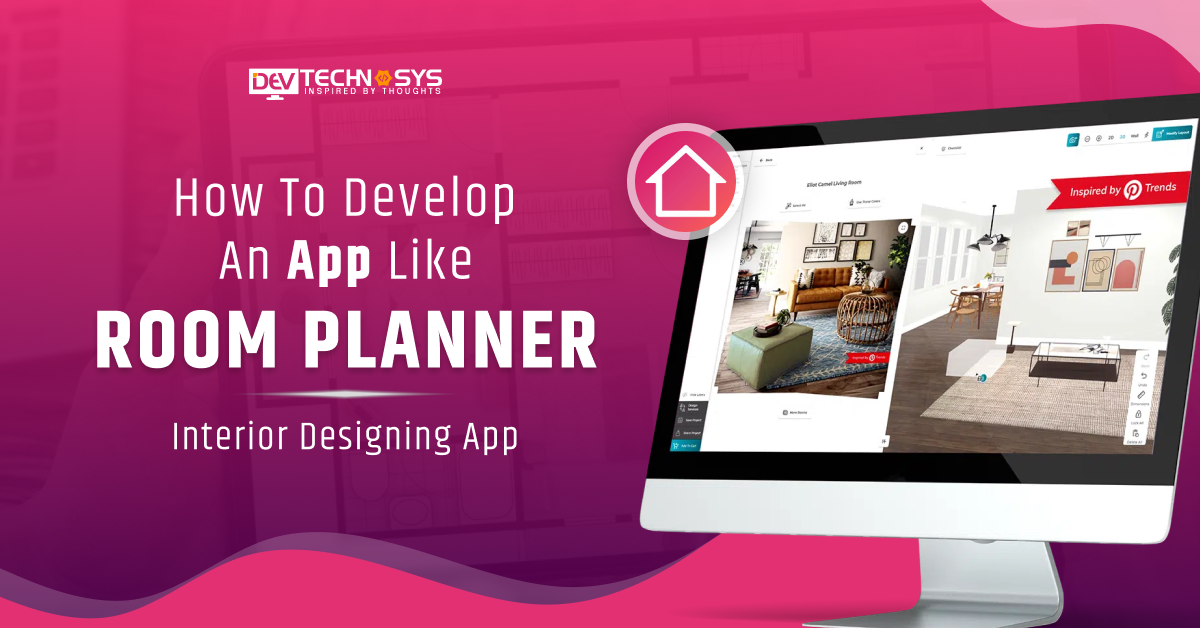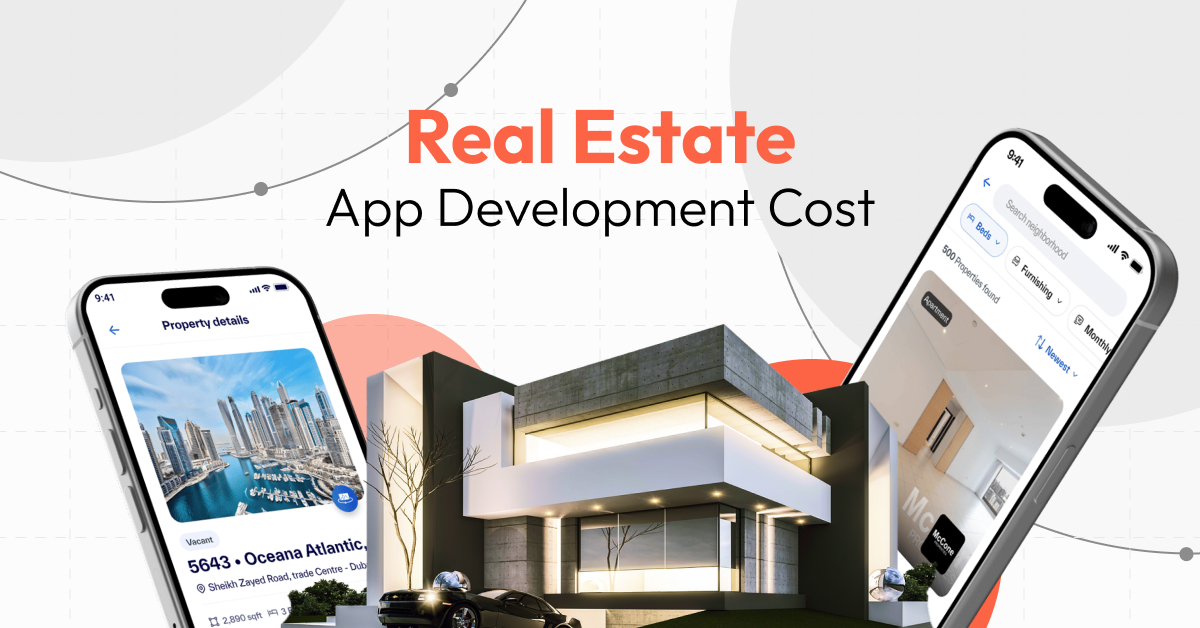Designing a beautiful home or office space is no longer something only professionals can do. Thanks to mobile technology, anyone can now try their hand at interior design using easy-to-use apps like Room Planner.
However, if you’re planning to develop an app like Room Planner, you’re entering a market full of opportunities. The global interior design software market was worth $3.3 billion in 2022 and is expected to grow to $6.2 billion by 2032, with a steady growth rate of 6.7% every year.
This rising trend shows that more and more people are using digital tools for home makeovers, space planning, and furniture placement. Investing in Room Planner app development helps businesses to expand in this thriving designing market.
In this blog, we’ll guide you through the key steps to develop an interior design application like Room Planner and highlight its main features and important details you should know before getting started.
So, let’s begin!
What is a Room Planner App?
A room planner app helps users design and arrange rooms easily. They can create floor plans, add furniture, and see how everything fits before making real changes. It is the best room planner app which is like a virtual version of home where they can try different layouts, colors, and styles.
Whether a user is moving into a new place or redecorating their current one, this virtual room planner app makes planning simple and fun. Many best AI interior design apps come with drag-and-drop features and 3D views, so they can visualize their space better.
Future Predictions & Projections of Interior Designing App
- In 2023, the world market for interior design was worth $136.12 billion. By 2033, the world market for interior design is expected to be bigger than $228.01 billion.
- A poll about living habits in South Korea in October 2022 found that Today House was the most popular interior design website, with 77.6% of people answering that it was their favorite.
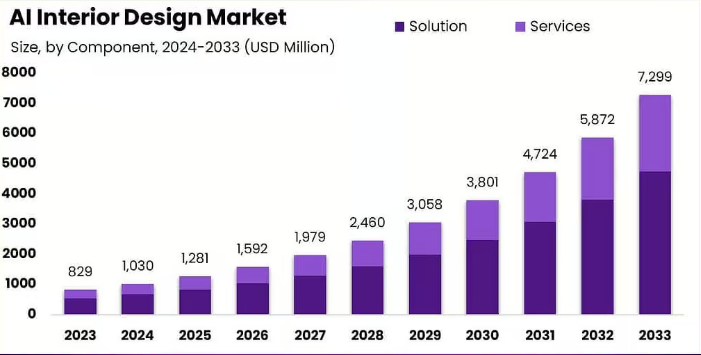
Source: Market.us
- The world market for creative best AI interior design apps was worth USD 412.06 million in 2022, and it’s expected to grow to USD 7,754.83 million by 2032.
- It is predicted that the market for the best interior design software and home styling assistant will grow at a CAGR of 34.11% from 2023 to 2032.
How Does A Room Planner App Work?
A 2D room planner app works by integrating advanced design tools with user-friendly features. It helps users to visualize and plan their space effectively. So, before you build an AI interior design app, let’s have a look at the working mechanism.
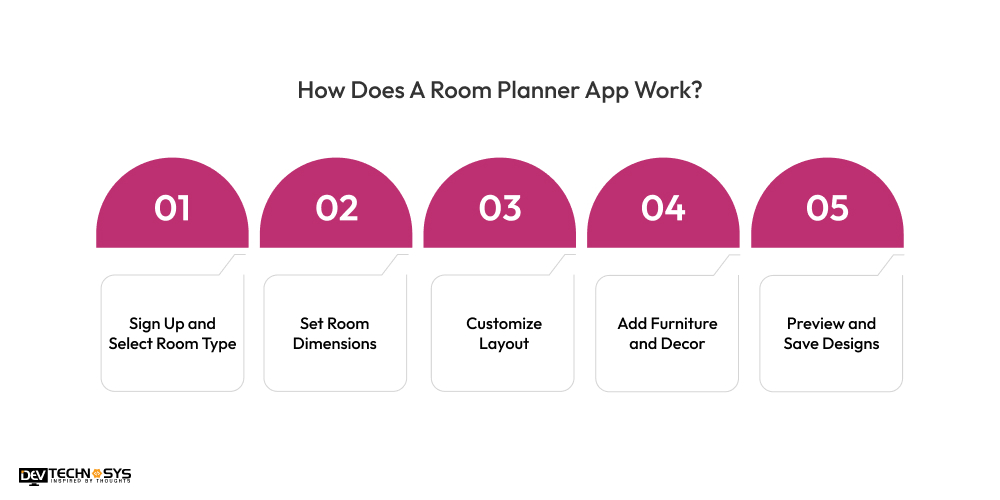
1. Sign Up and Select Room Type
Users begin by downloading the room furniture planner app, signing up, and selecting the type of room they want to design: bedroom, living room, kitchen, etc.
2. Set Room Dimensions
Next, users enter the room’s measurements or use built-in tools to scan and auto-generate the layout. This app similar to Room planner helps create an accurate floor plan.
3. Customize Layout
Users can drag and drop walls, doors, and windows or adjust existing layouts to match their actual space. Some 2D interior design apps offer templates for easy customization.
4. Add Furniture and Decor
From sofas to shelves, users browse the furniture catalog and place items within the room. Most Interior Decor apps offer 2D or 3D views for better visualization.
5. Preview and Save Designs
Once done, users can preview the design in 3D, make edits, save the layout, and even share it with professionals or friends for feedback.
How To Build An App Like Room Planner?
Building an application like Room Planner can be an exciting journey, especially if you’re aiming to help users design their dream spaces digitally. So, if you’re looking to make an app like Room Planner, here are the simple steps you should follow.
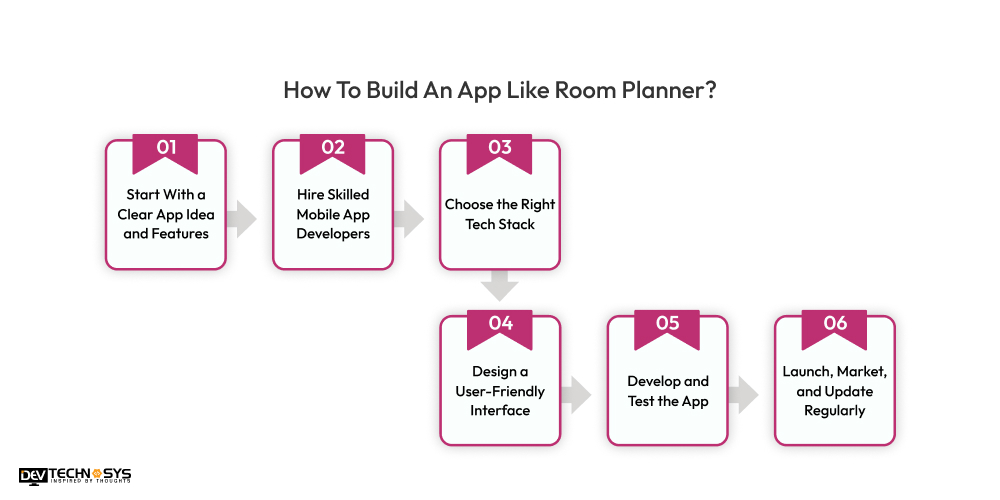
1. Start With a Clear App Idea and Features
Before you jump into coding, it’s important to define your home styling app’s purpose and what features it will offer. Look at apps like Room Planner and note down key features such as drag-and-drop furniture tools, 3D room views, wall and floor editing, and save or share options.
Think about your target audience for floor design app development. Are you building this for homeowners, interior designers, or real estate agents? Also, decide if your app will have free and premium features. Creating a wireframe or sketch of the app similar to Room planner layout can help you and your mobile app developers stay on the same page.
|
2. Hire Skilled Mobile App Developers
To turn your idea into reality, you need a strong team of mobile app developers. Look for developers who have experience in 3D modeling, AR/VR, and user-friendly UI design. They can help you choose the right tech stack whether you want to develop an app like Room Planner for iOS, Android, or both.
A good mobile app development company will also ensure smooth performance, handle backend setup, and make your ikea room planner app visually appealing and functional. If you don’t have an in-house team, consider outsourcing to a reliable interior designing app development company.
|
3. Choose the Right Tech Stack
Now it’s time to decide the technologies you’ll use. Do you want your room space planner app on iOS, Android, or both? You can build it natively or use cross-platform tools like Flutter or React Native.
For 3D design and rendering, an iPhone app development services provider often uses Unity, Unreal Engine, or WebGL. It’s best to work with experienced mobile app developers who can suggest the best tech stack based on your home styling app’s needs, budget, and timeline.
|
4. Design a User-Friendly Interface
Once you have your features ready, it’s time to design the interior layout app. The user interface (UI) is everything here. Your app should be simple, smooth, and visually appealing.
The Android app development company can use clear icons, drag-and-drop functionality, and neat layouts to guide users. Make sure your interior architecture app similar to Room planner works well on all devices and screen sizes.
You can even create design mockups or wireframes first to see how everything will look before you start coding. Think about user experience from start to finish—how someone enters the app, designs a room, and saves their project.
|
5. Develop and Test the App
Now it is where a floor design app development company can develop an app like Room Planner. Begin with an MVP that includes the core features like creating and saving room designs.
Once the basic version is ready, test it with real users to collect feedback. Testing is super important. Make sure the home renovation app runs smoothly, has no bugs, and works well across devices. Test all features like zoom, rotate, drag-drop items, and login/signup functions. Keep improving the app based on the feedback you receive.
|
6. Launch, Market, and Update Regularly
After testing, it’s time to launch your app on the App Store and Google Play. Promote your app using social media, influencers, and home makeover app review sites. Let people know how easy and fun it is to plan their dream room.
Also, don’t stop after the launch. Keep updating the home renovation app with new features, furniture catalogs, and better user experiences. Regular updates help retain users and keep your home design app competitive.
|
Key Features Room Planner App Development
Before you begin room planner clone app development, it’s important to include features that offer users a seamless, intuitive, and enjoyable experience. Below are the must-have features you should add to your 3D room planner app:
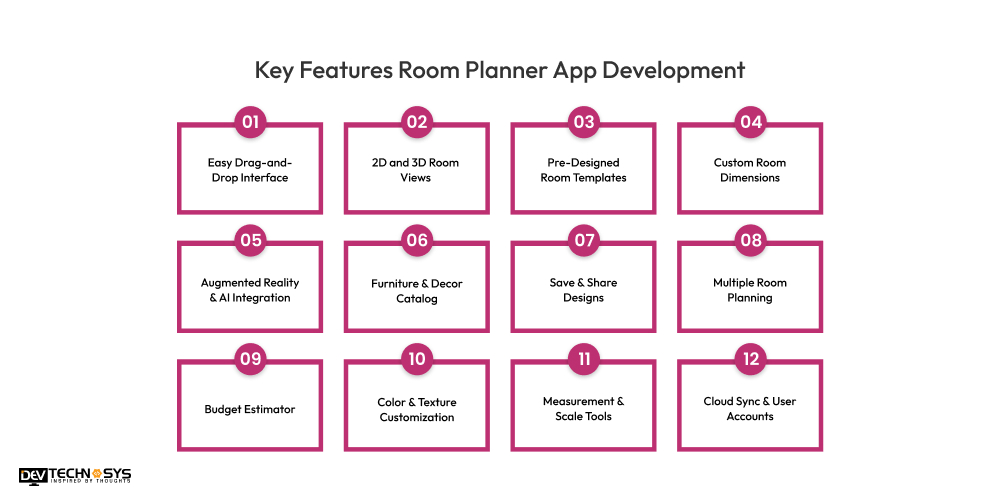
1. Easy Drag-and-Drop Interface
Users can simply drag and drop furniture and decor items into their virtual room. It’s as easy as playing a game—no technical skills needed. This makes room planning fun and interactive for everyone.
2. 2D and 3D Room Views
Let users view their rooms in both 2D and 3D formats. 2D helps with layout, while 3D offers a realistic feel. Switching between views allows for better visualization before making real changes in app similar to Room planner.
3. Pre-Designed Room Templates
The kitchen interior design software offers ready-made room layouts to help users get started quickly. Whether it’s a bedroom, kitchen, or office, templates save time and inspire creativity.
4. Custom Room Dimensions
Allow users to input their exact room size. Whether it’s a small studio or a spacious home, users can create layouts that match real-life dimensions for accurate planning.
5. Augmented Reality & AI Integration
With AI in smart home automation, users can use their phone cameras to see how furniture will look in their actual room. It bridges the gap between imagination and reality, improving decision-making.
6. Furniture & Decor Catalog
The online room planner app similar to Room planner provides a rich catalog of furniture, decor, lighting, flooring, and more. Users can explore different styles and brands to mix and match until they find the perfect look.
7. Save & Share Designs
Users should be able to save their room designs and share them with friends, family, or interior designers for feedback. Social sharing also helps boost home interior design software and home design app visibility.
8. Multiple Room Planning
Give users the ability to plan multiple rooms within the same project. Whether it’s the whole house or a single room, users can switch between different areas easily.
9. Budget Estimator
A built-in budget calculator lets users keep track of costs while designing. As they add furniture or decor, the home design app automatically adds up the total, helping users stay within budget.
10. Color & Texture Customization
When you develop a smart home app, allow users to customize wall colors, flooring, furniture finishes, and more. They can try various color combinations and textures to match their personal style or experiment freely.
11. Measurement & Scale Tools
When you develop an app like Room Planner, you can provide built-in tools for measuring space and ensuring all furniture fits perfectly. This feature avoids overcrowding and ensures smooth movement within the room.
12. Cloud Sync & User Accounts
A home service app development company can integrate this feature interior designing app. Also you can allow users to create accounts and sync their projects to the cloud. This way, they can access their saved designs anytime, from any device.
Best Interior Designing Apps Like Room Planner
The best room designing apps have changed the way people plan and decorate their spaces. Among the top choices, Room Planner stands out for its intuitive 3D design capabilities. However, there are several other Room Planner alternatives offering similar features and ease. So, let’s get to know each with a table.
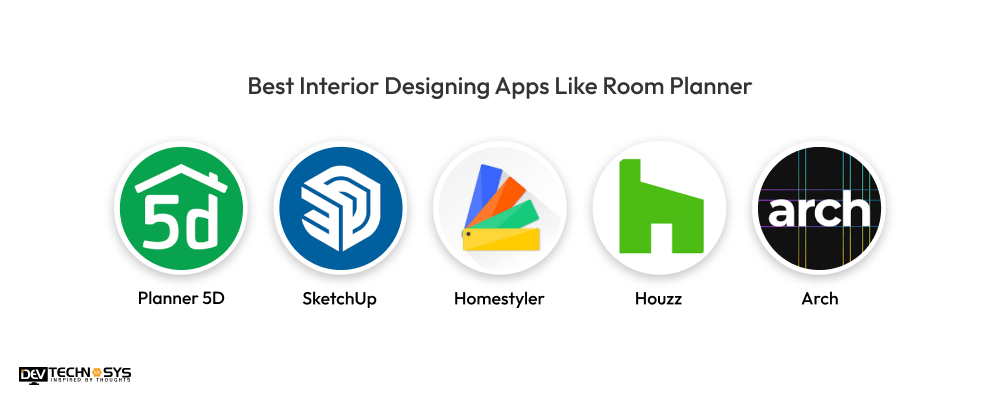
Top Apps Like Room Planner |
Available Platform |
Downloads |
Ratings |
| Planner 5D | Android | iOS | 10M+ | 4.0 |
| SketchUp | Android | iOS | 1M+ | 3.6 |
| Homestyler | Android | iOS | 10M+ | 3.9 |
| Houzz | Android | iOS | 10M+ | 4.5 |
| Arch | Android | iOS | 1M+ | 4.4 |
How Much Does it Cost to Develop An App Like Room Planner?
The cost to develop an app like Room Planner can range between $10000 – $25000. However, this interior designing app development cost can fluctuate depending on your project requirements.
Also, the level of features customization and designs can increase the cost to build an app like Room Planner. So, it is vital to get in touch with an AI development services provider for an actual cost estimation as per your requirements.
Then only you should set your budget and plan the strategy. Now let’s look at the factors affecting the Room Planner app development cost.
1. Design Complexity
Design plays a huge role in user experience, especially for a home design app focused on home planning and aesthetics. A clean, intuitive, and visually appealing UI/UX requires careful planning and professional design skills.
If you want custom animations, high-resolution 3D models, and smooth navigation, the design process will require more resources, which adds to the Room Planner app development cost.
Design Complexity Level |
Estimated Design Cost |
| Basic | $4000 – $8000 |
| Medium | $8000 – $15000 |
| Complex (within budget) | $20000 (Slightly exceeds upper limit) |
2. App Features and Functionality
The more features you want, the more you’ll need to invest. A basic version of a room planner app with essential tools like drag-and-drop furniture, 2D/3D room views, and simple layouts will cost less.
However, if you want advanced features like AR room previews, virtual tours, smart suggestions, and integration with furniture brands, the cost to build software for interior design will rise accordingly. More features also mean longer development time.
Feature/Task |
Estimated Cost |
| Basic UI/UX Design | $300 – $700 |
| 2D Floor Plan Creation | $400 – $800 |
| Simple Furniture Catalog | $300 – $600 |
| Save/Load Functionality | $200 – $400 |
3. Platform Choice
Do you want to develop an app like Room Planner for Android, iOS, or both? Developing for one platform is cheaper and faster, but it limits your user base. Cross-platform app development using frameworks like Flutter or React Native can help save time and money, while native development (building separately for Android and iOS) offers better performance but AI Room Planner app development costs more.
Platform Type |
Estimated Cost Range |
| Native Android | $12,000 – $20,000 |
| Native iOS | $13,000 – $22,000 |
| Cross-Platform | $15,000 – $25,000+ |
4. Development Team & Location
The cost to hire mobile app developers varies by region. Developers in North America or Western Europe generally charge more than those in Asia or Eastern Europe.
If you hire a full in-house team, the cost will be higher compared to outsourcing your project to an experienced DIY interior design app development company. Always choose a team with expertise in AR/VR, 3D design, and interior visualization app scalability for the best results.
Location |
Hourly Rate |
| India | $15 – $25 |
| Southeast Asia | $30 – $55 |
| Eastern Europe | $30 – $80 |
| South America | $30 – $90 |
| Western Europe | $70 – $150 |
| North America | $100 – $200 |
| Australia | $90 – $120 |
How to Monetize an Interior Designing Application like Room Planner?
Monetizing an interior designing application like Room Planner isn’t just about adding ads or selling subscriptions—it’s about creating value for users and offering them options based on their needs. So, choose the best monetization models for earning huge money from your Room Planner clone app.
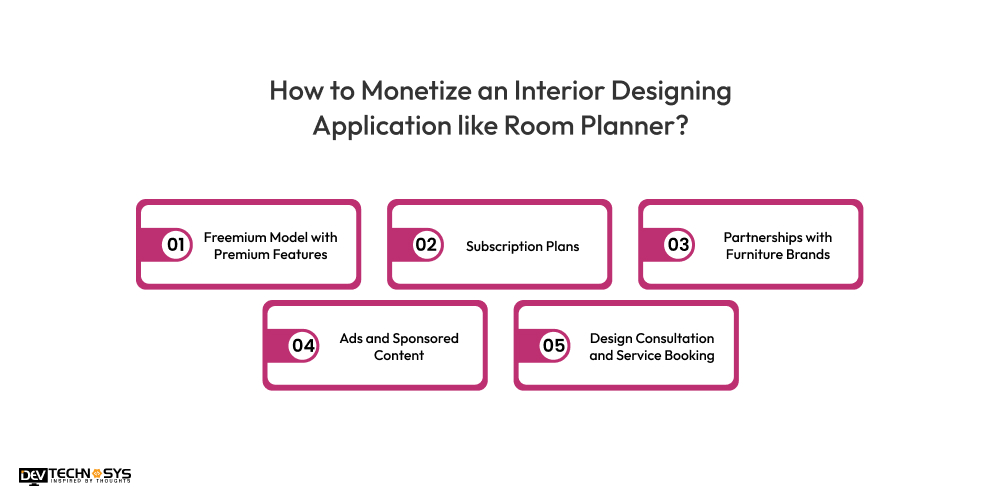
1. Freemium Model with Premium Features
One of the best ways to earn money from an interior designing app like room planner is by offering a freemium model. The AI exterior home design app development solution can access basic features like browsing room layouts, trying out a few furniture pieces, or designing a simple room for free.
However, if they want to unlock more advanced features—like high-resolution 3D views, exclusive furniture collections, custom textures, or full house plans—they’ll need to upgrade to a premium version by paying a subscription or one-time fee. This living room planner app keeps new users interested while encouraging serious users to pay for extra features.
2. Subscription Plans
Offering monthly or yearly subscription plans is another excellent way to generate recurring revenue. You can create different tiers for hobbyists, professional designers, or businesses.
Each tier can offer exclusive 3D home design tools such as unlimited design projects, custom branding, high-resolution exports, and access to a larger furniture catalog.
Subscriptions provide stable and predictable income and encourage long-term app usage. You can also include a free trial period to let users explore the premium features before they commit.
3. Partnerships with Furniture Brands
You can also partner with real furniture and home decor brands to make money. Allow users to browse virtual interior design apps like Houzz and place actual branded products in their designs, and then link those items to an online store for purchase.
When a user clicks to buy an item or visits the store through your app, you earn a commission or referral fee. This not only helps users get real-life design solutions but also builds trust by showing them products they can actually buy.
4. Ads and Sponsored Content
If you have a large number of users on the app, you can run targeted ads and earn revenue. Choose non-intrusive ads like sponsored interior design blogs, video tutorials, or banners from furniture companies.
You can also allow brands to feature their products as top suggestions within the design tool. For example, a brand might pay you to feature their new dining table set in your “Most Used” category. Just make sure the ads blend naturally with the app experience, so they don’t annoy users.
5. Design Consultation and Service Booking
Take things a step further by offering professional interior design services through the on demand app development solutions. Users who need expert help can book a consultation with certified interior designers directly from the app.
You can charge a service fee or commission on each booking. It’s a win-win—users get personal design advice, and your app becomes more valuable. You can also allow freelancers or companies to list their services on your platform for a small listing or subscription fee.
Let’s Create an App Like Room Planner!
Ready to turn your dream 3D interior design app into reality? Start the process to develop an app like Room Planner with the right mix of features, technology, and creativity. To make your idea successful, partner with a skilled AI development company that understands your goals.
From 3D visualization to AR tools, professionals can craft a user-friendly app tailored to your audience. So, don’t wait, team up with the experts and bring your interior design vision to life today!
FAQs
Q1. How Much Does It Cost To Build An Application Like Room Planner?
It typically costs $10,000 to $25,000 to build a Room Planner-like app, depending on app features, design complexity, tech stack, and the development team’s location and experience.
Q2. How Long Does It Take to Create An App Like Room Planner?
Developing an interior design application like Room Planner usually takes 2 to 6 months, covering UI/UX design, backend development, testing, and deployment, depending on features and platform (iOS, Android, or both).
Q3. How to Develop an Interior Designing App?
- Conduct market research
- Choose tech stack & platform
- Design user-friendly UI/UX
- Integrate 3D modeling tools
- Develop & test the app
- Launch and maintain
Q4. What Are the Benefits of Interior Designing App Development?
- Attracts tech-savvy users
- Offers real-time space visualization
- Enhances client satisfaction
- Reduces manual effort
- Increases revenue through service automation
Q5. How To Earn Money From A Room Planner Clone App?
- Subscription plans
- In-app purchases
- Ads and promotions
- Partner with furniture brands
- Offer premium 3D interior planner tool
